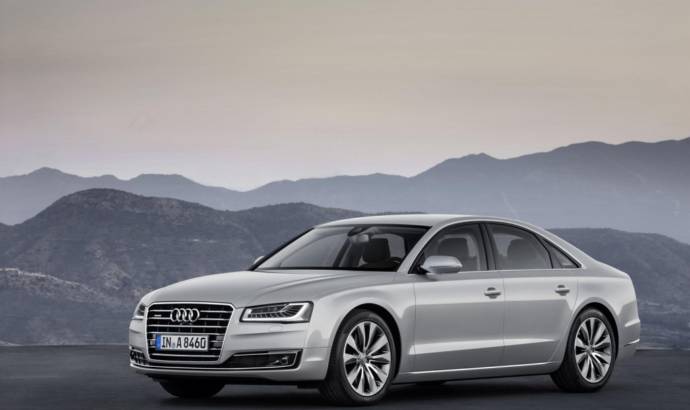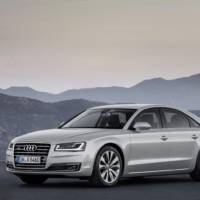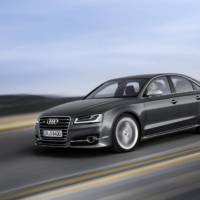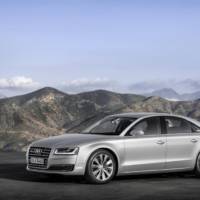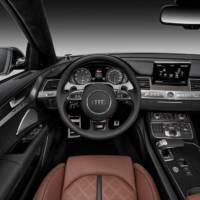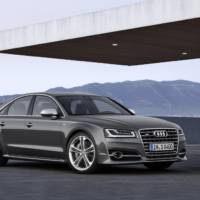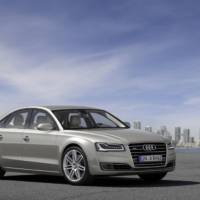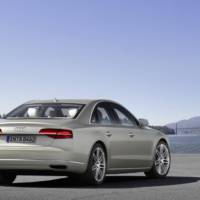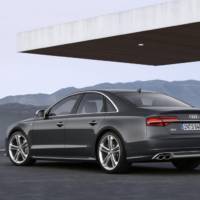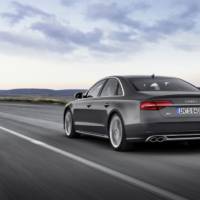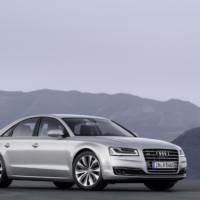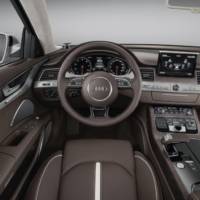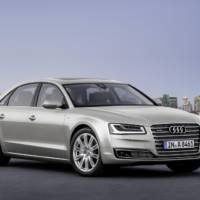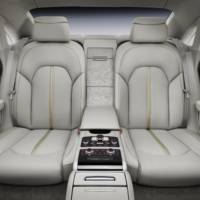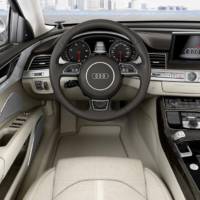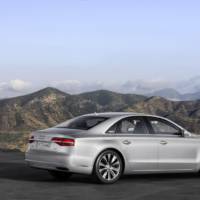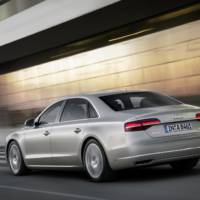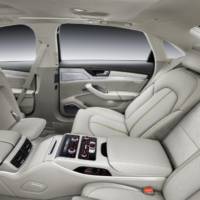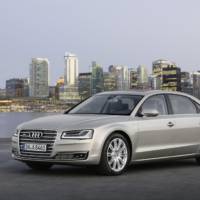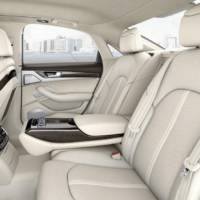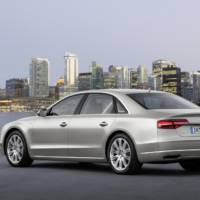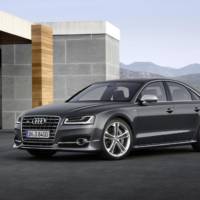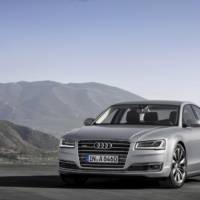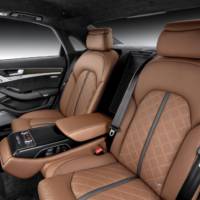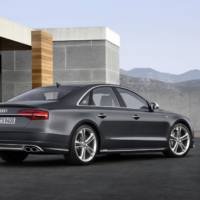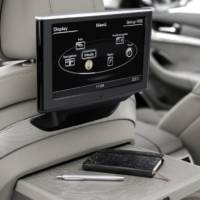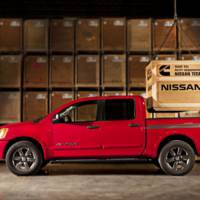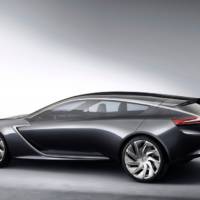Audi has given its flagship, the A8, a wide-sweeping update. The engines are even more powerful and efficient, while new assistance systems and the innovative Matrix LED headlights provide for an added level of composure.
The new A8 places Audi among the innovation leaders in the luxury segment. One great strength of the big sedan is its lightweight construction. The Audi A8 3.0 TFSI with the normal wheelbase has a curb weight of just 1,830 kilograms (4,034.46 lb) – best-in-class for models with all-wheel drive. The body is made almost entirely of aluminum; an Audi Space Frame (ASF) design, it weighs just 231 kilograms (509.27 lb).
Length (5.14 meters [16.86 ft]), wheelbase (2.99 meters [9.81 ft]), width
(1.95 meters [6.40 ft]) and height (1.46 meters [4.79 ft]) remain unchanged, making the Audi A8 the sportiest sedan in the segment. The A8 L gains an additional 13 centimeters (5.12 in) in both length and wheelbase. Both body variants feature a new trunk layout for easier loading. Additional noise damping measures reduce the already low interior noise level even further.
The dynamic design of the big sedan has become even more expressive. The engine hood, the Singleframe grille and the front bumper are even more sculptured; the lower edge of the headlight units is straight. In the German market, LED headlights are standard in all models with a V8 engine. Audi also offers optional headlights featuring Matrix LED technology, which sets new benchmarks with respect to design and technology. With these headlights, the high-beam comprises 25 individual light-emitting diodes per unit that can be switched on and off or dimmed individually depending on the situation.
This enables the headlight system to react extremely precisely to other vehicles while always brightly illuminating the road. Additional features of the new headlights are the intelligent cornering light, new-look daytime running lights and dynamic turn signals. The lighting system in the A8 uses predictive route data from the navigation system to adjust the distribution of light in response to the current driving situation. In combination with the optional Navigation plus with MMI touch, the system recognizes route data contained in the navigation system, such as curves and road classifications.
The LED lamps at the rear of the new Audi A8 have also become flatter. In all models except the S8, the redesigned bumper houses two rhomboid tailpipes. New chrome strips and high-gloss black window frames round out the differentiating design details. There is a choice of twelve colors, including five new ones. Wheels are available in sizes up to 21 inches.
Audi offer the A8 on the German market with two gasoline and two diesel engines. These are the supercharged 3.0 TFSI with 228 kW (310 hp), the V8 twin-turbo 4.0 TFSI with 320 kW (435 hp), the highly efficient 3.0 TDI clean diesel with 190 kW (258 hp) and the extremely high-torque 4.2 TDI clean diesel, which produces 283 kW (385 hp) and 850 Nm (626.93 lb-ft).
Performance has increased with most engines. When paired with quattro all-wheel drive, the 4.0 TFSI now accelerates the A8 from 0 to 100 km/h (62.14 mph) in 4.5 seconds. Under partial load, the Audi cylinder on demand (COD) system deactivates four of the eight cylinders. The most efficient engine is the 3.0 TDI clean diesel, which consumes just 5.9 liters of diesel per 100 kilometers (39.87 US mpg), which corresponds to 155 grams CO2 per kilometer (249.45 g/mile) All engines satisfy the Euro 6 standard. Friction-reducing measures reduce consumption by as much as 10 percent.
These variants are joined by three additional models. The top-of-the-line model is the luxuriously equipped Audi A8 L W12 quattro. Its gasoline engine is particularly short and lightweight thanks to its W layout. Displacing 6.3 liters, it produces 368 kW (500 hp). It also boasts best-in-class fuel consumption of 11.7 liters per 100 kilometers (20.10 US mpg), corresponding to 270 grams CO2 per kilometer (434.52 g/mile). It also has a COD system that was designed specifically for it. At low load, it deactivates the fuel injection and ignition for six cylinders. The available Active Noise Cancellation (ANC) ensures excellent acoustic comfort.
With 380 kW (520 hp), the S8 is Audi’s big sports sedan. Paired with quattro all-wheel drive, its sonorous 4.0 TFSI accelerates the S8 from 0 to 100 km/h (62.14 mph) in 4.2 seconds. Average fuel consumption for the S8 is just 10.1 liters per 100 kilometers (23.29 US mpg), corresponding to 235 grams CO2 per kilometer (378.20 g/mile). The COD system plays a key role here, too. Active Noise Cancellation (ANC), a technology that is also used in the A8 4.0 TFSI quattro, the A8 L W12 quattro and the A8 hybrid, uses precise antiphase noise to compensate for intrusive noise in the cabin while operating on four cylinders while active engine mounts dampen vibration. The chassis and many body details reflect the sporty positioning of the S8.
The Audi A8 hybrid combines a 2.0 TFSI and electric motor to produce a system output of 180 kW (245 hp) and system torque of 480 Nm (354.03 lb-ft). The engine’s power flows to the front wheels via a modified tiptronic. The lithium-ion battery in the rear enables purely electric driving at up to 100 km/h (62.14 mph) with a range of roughly three kilometers (1.86 miles). The A8 hybrid consumes on average just 6.3 liters of fuel per 100 kilometers (147 grams CO2 per kilometer [37.34 US mpg/236.57 g/mile]).
The new Audi A8 is scheduled to arrive at German dealerships in November. Despite the upgraded trim level (standard LED headlights in all V8 models) and the powerful engines, prices are changing only slightly. Prices in Germany for the new Audi model start at 74,500 euros.

